Notes
What’s in a “Top 100 Photos of the Year” List?

Smoke hides ‘ninots’ or giant figures depicting doves of peace fighting over an olive branch by artist Escif, and the buildings of Plaza del Ayuntamiento during the ‘Mascleta,’ an explosive barrage of firecrackers and fireworks during the traditional annual Fallas Festival, in Valencia, Spain, on March 15. Eva Manez—Reuters
TIME’s Top 100 Photos of 2024 captures the year’s defining crises, from war and climate disasters to political polarization. This analysis explores what the images reveal—and what they leave out.
By Michael Shaw
Every year-end, media organizations and news photo publishers ritually curate their choice of best images. Both poignant reminders and feasts for the eye, these vivid collections often leave me scratching my head about what they reflect overall.
My analysis looks at the makeup of TIME’s 100 Photos of the Year, focusing on news and political imagery, excluding sports, entertainment, human interest photos, and natural disasters.
While the sculpture of peace doves fighting over an olive branch fell outside the 76 relevant images I analyzed, it’s a worthy leadoff for a world of concern.
The Climate Emergency (16 Photos)

(1). A resident wades through Typhoon Toraji flooding in Ilagan City, Philippines, Nov. 12. Noel Celis—AP (2). A resident assists a car stranded by Tropical Storm Helene in Boone, N.C., Sept. 27. Jonathan Drake—Reuters (3). A woman watches vehicles trapped by floods from her balcony in Valencia, Spain, Oct. 30. Alberto Saiz—AP (4). An aircraft sits abandoned on the flooded tarmac in Porto Alegre, Brazil, May 20. Anselmo Cunha—AFP/Getty Images (5). El Niño accelerates ice shelf melting in West Antarctica, Feb. 10. Jasper Doest (6). Fire advances through Brazil’s drought-stricken Pantanal wetlands, August. Lalo de Almeida—Panos Pictures
Welcome to the elephant in the room. Persistently present yet widely ignored, the climate emergency is the greatest existential threat to humanity.
Give TIME credit for the coverage highlighting a range of impacts, from immediate disasters to system collapse. The imagery balances personal stories, environmental damage, and ecosystem-scale effects. A resident wading through Typhoon Toraji’s unimaginable flooding in the Philippines and a woman surveying the so-named “car soup” from her balcony in Valencia personalize the crisis. In contrast, systemic issues like ice shelf melting in West Antarctica and fires consuming Brazil’s Pantanal wetlands illustrate broader ecological breakdown.
Lethality is one of the most understandable ways to scale climate impact. By that measure, Typhoon Yagi in the Philippines is this year’s most significant global warming-charged catastrophe by far (844 deaths). By comparison, Hurricane Helene in the Caribbean and the U.S., the flooding in Spain, and the flooding in Brazil each accounted for a third as many fatalities.
Meanwhile, an estimated 47,000 people died in Europe alone due to extreme heat and humidity in 2024, over 1,300 just from the pilgrimage to the Hajj in Mecca. And yet, Hurricane Helene was featured in five of the 16 images. At the same time, critical phenomena such as heat waves and drought—among the most devastating climate effects in the U.S. and elsewhere—were absent from the list altogether.
Climate denial and how the media becomes preoccupied with or lightly touches on these cataclysmic effects brings us to an image from Viña del Mar, Chile, that says everything about humanity’s detachment from the crisis and its escalation.
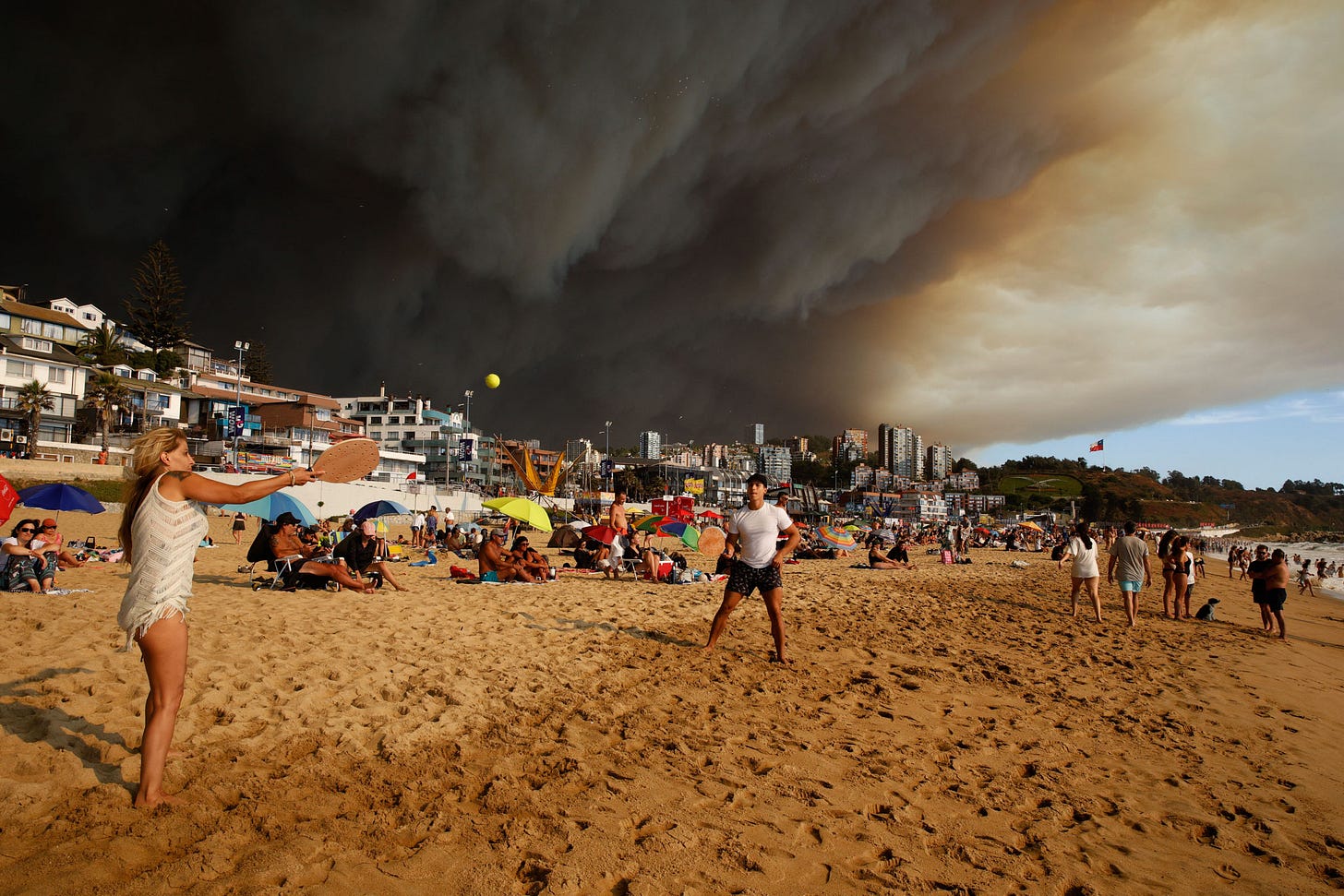
Vacationers play paddle ball as nearby forest fires burn in Viña del Mar, Chile, Feb. 2. Martin Thomas—Aton Chile/AP.
It is a stark reminder of our collective failure to confront the climate emergency head-on, even as its effects are impossible to ignore.
Israel-Gaza War (14 Photos)

1. An Israeli family holds a bar mitzvah in an underground bomb shelter near Nahariya after Hezbollah rocket attacks following their commander’s killing in Lebanon. Amit Elkayam. 2. A child looks through a broken window in Rafah, where 1.5 million displaced Palestinians sought refuge from Israeli forces. Fatima Shbair—AP. 3. A Hezbollah member shows injuries from a pager explosion in Beirut during September sabotage attacks that killed 42 and wounded 3,000. William Daniels. 4.Tuqa Ossama Ibrahim, 12, who lost her legs in a Gaza airstrike, sits in her wheelchair during Ramadan at Emirates Humanitarian City. Amr Alfiky—Reuters. 5. Families of Gaza hostages complete a four-day march to Jerusalem, pressing the Israeli government for a ceasefire deal with Hamas. Tamir Kalifa. 6. Layan Harouda, 15, a Gaza refugee, floats in Qatar’s waters while reflecting on war trauma and an uncertain future. Tanya Habjouqa
With 14 photos plus eight related protest images, the Israel – Gaza war constitutes nearly 30% of TIME’s 76 news and political selections.
Perhaps the most notable aspect of the list, however, is how the visual distribution breaks from the typical media “bothsideism,” in which articles and photo galleries often show equal numbers of images per side. In TIME’s list, nine photos depict Palestinian or Lebanese losses, and five focus on Israeli impacts, reflecting the asymmetric nature of the conflict and the tens of thousands of Palestinians killed and the hundreds of thousands displaced.
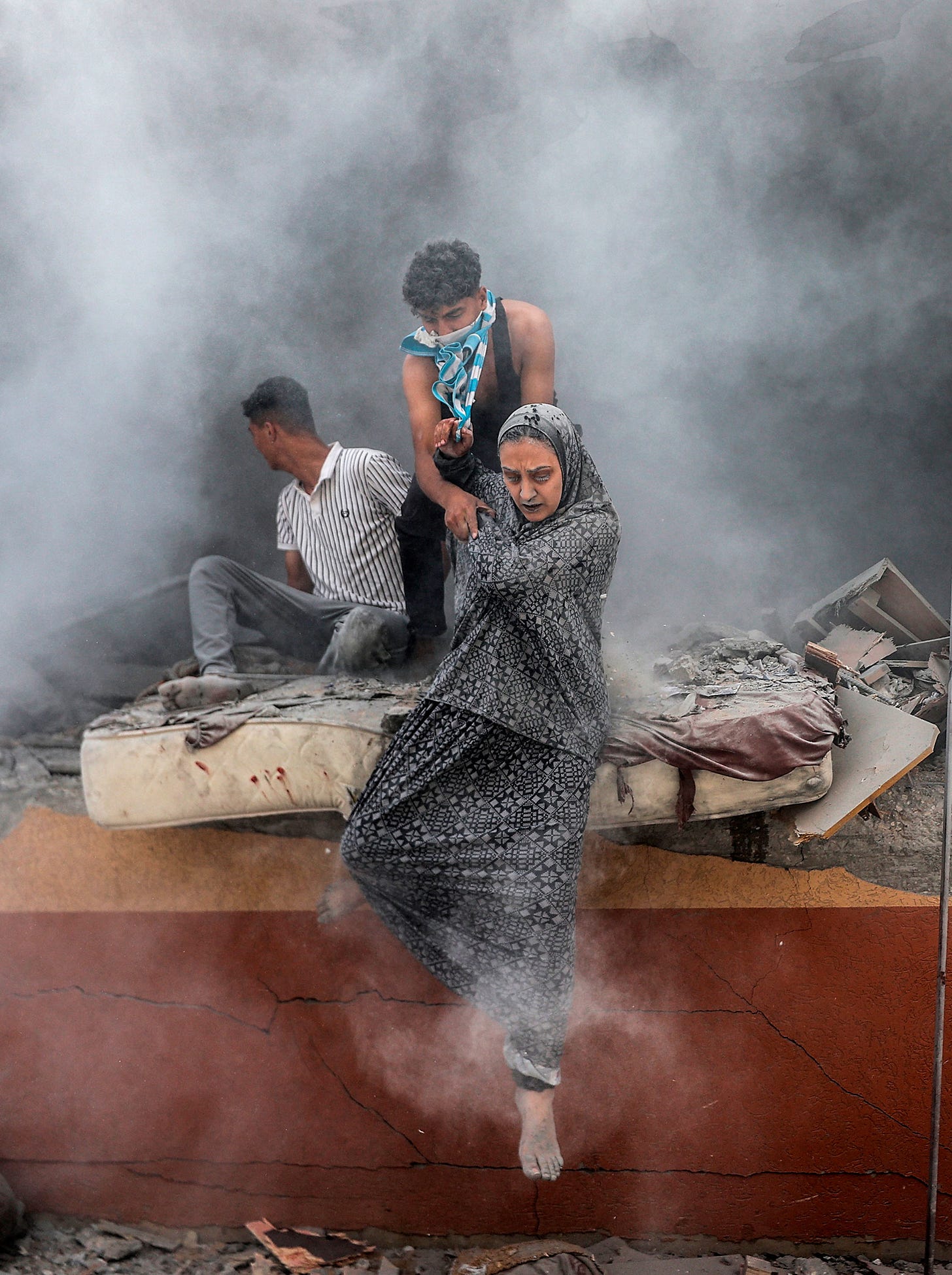
Palestinians emerge from the rubble and dust after an Israeli attack hit the Abu Aisha family’s house in Deir al-Balah, Gaza, on June 14. Ali Jadallah—Anadolu/Getty Images
This particularly haunting scene, punctuated by the fog pouring from the rubble and the woman’s face covered in ash, symbolizes how the Gazans have become like ghosts. And the raft-like mattress conjures a voyage of the damned.
The Presidency and the U.S. Campaign (12 Photos)
- Elon Musk joins Donald Trump at a Butler, Pennsylvania rally where the former president survived an assassination attempt three months earlier. Jim Watson—AFP/Getty Images
- Vice President Kamala Harris appears with her SNL impersonator Maya Rudolph during the show’s pre-election cold open in New York. Haiyun Jiang—The New York Times/Redux
- G7 leaders gather to watch a parachute demonstration on the opening day of the 50th summit at San Domenico Golf Club in Fasano. Antonio Masiello—Getty Images
The fact the images skew to the theatrical (Elon’s reverie; Harris on SNL; a goofy pic including Biden at a G7 summit) explains the thumbnails here.
More accurately, of the twelve images (Trump 6, Biden 3, Harris 3), the Harris images suggest legitimacy-building through political gravitas and relatable appeal. The Trump images are a more theatrical blend centered on conflict and resilience, populism, and defiance. Biden’s visual treatment implies diminishing influence through distance or removal.
Quantitatively, I can understand the smaller number of photos of Harris, given her late entry into the presidential race. Just three for Biden, election year or not, is a flashing red light. In seeking out reasons, one can argue for diminished capacity, but Biden
also proved a terrible communicator, especially a visual one, for the entire four years.

Former President Donald Trump is shown covered by U.S. Secret Service agents after an assassination attempt during a rally for the Republican presidential candidate in Butler, Pa., on July 13.Anna Moneymaker—Getty Images
In July, I wrote about how Trump stage-managed the assassination attempt and how the media colluded with him to elevate the most heroic vision of the event. The viral and celebrated photo of a bloody Trump waving his fist in front of the flag is in the TIME edit. Here, however, I’m presenting Anna Moneymaker’s version of a stricken candidate that, in a normal world, would have been the most telling of what went down.
Protest (10 Photos)

(1) A protestor is detained by police during a pro-Palestine march to the Manhattan Bridge in Brooklyn, NY, on May 11. Olga Federova—EPA-EFE/Shutterstock, (2) New York City Police arrests a pro-Palestinian protestor during a demonstration calling for a permanent ceasefire in Gaza, on Monday, Feb. 12, in New York. Several protesters were arrested as the NYC government implemented measures to restrict pro-Palestinian demonstrations. Andres Kudacki for TIME. (3) Police grab a protester as they break up an encampment on the University of Texas campus, on April 29. Lorianne Willett
Five of the nine protest images in TIME’s list deal with pro-Palestinian protests—three showcase confrontation, chaos, or violence.
Did the Israel-Gaza war dominate social uprisings in 2024, or was the movement—particularly on college campuses—an overwhelming draw for the media and visual journalism? What the list overlooks, just like the coverage last spring, is that the overwhelming majority of protests, especially on college campuses, were peaceful.
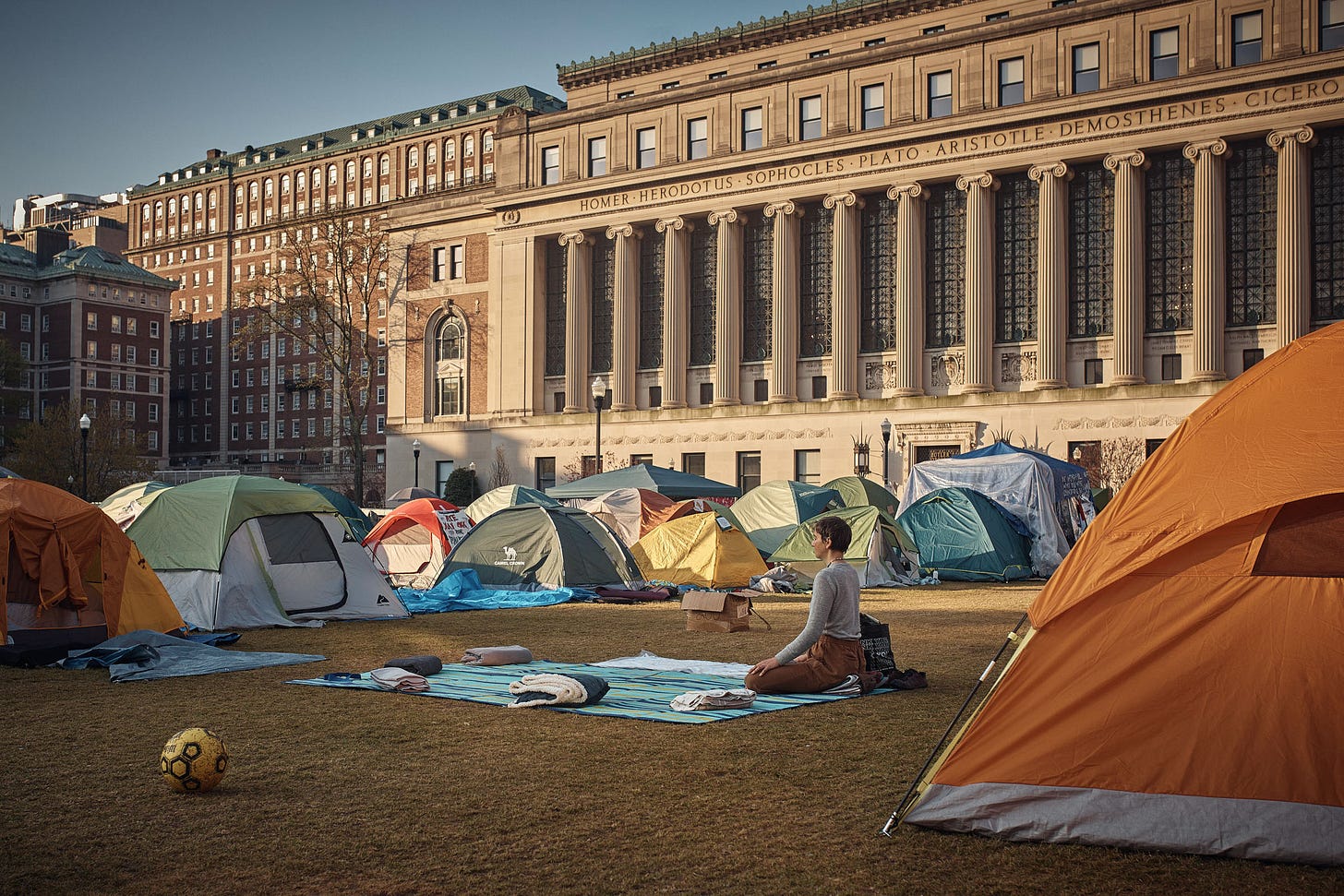
A protestor meditates early Monday morning inside the pro-Palestinian encampment on Columbia University campus in New York City on April 29. Andres Kudacki for TIME
This photo from Columbia University is also worth mentioning for its aesthetics—a factor that becomes a concern whenever an image’s situation, tone, or allure fails to align with the fundamental nature of the news event. In the case of the protest photo, the warm, golden light and soft hues lend the picture an undeniable beauty, casting a tranquil glow over the pro-Palestinian encampment.
The meditative figure in the foreground and the nearby soccer ball, framed by the orderly rows of tents and Butler Library’s imposing classical facade, create a sedate, almost tranquilized scene. Yet this aesthetic—the meditator set against a backdrop of philosopher’s names etched in stone, figures who evoke a legacy of speaking truth to power—stands in stark contrast to the tension of the defiance and the violent institutional backlash that roiled the institution.
Russia-Ukraine War (9 Photos)
- An emergency worker evacuates residents from Vovchansk in May as Russian forces launched a new offensive across the border, heavily shelling the area. Simon Townsley—Panos Pictures
- Injured Russian soldiers recover in an underground Bakhmut hospital, Jan. 22. Nanna Heitmann—Magnum Photos
- Volunteers clear rubble at Kyiv’s Ohmatdyt Children’s Hospital after a devastating Russian missile strike, July 8. Roman Pilipey—AFP/Getty Images
While American interest in the war has waned after its first year, TIME’s selections underscore the enduring power of conflict photography and its role in shaping public perception.
From an emergency worker evacuating civilians in a heavily shelled town to volunteers clearing rubble at a children’s hospital, the images prioritize human suffering and resilience over strategic developments. This focus aligns with TIME’s esteemed tradition of war photography, which seeks to humanize conflict and maintain attention on crises that might otherwise fade from view.
At the same time, it highlights the challenges inherent in editorial photography today. The reliance on dramatic, emotionally charged images risks contributing to visual fatigue, as audiences are inundated with similar scenes of destruction and despair.
Immigration/Refugee Crisis (7 Photos)
- A Venezuelan mother weeps while sharing her migration story with her daughter in El Paso. Christian Monterrosa—AFP/Getty Images
- A Texas National Guard soldier monitors migrants who crossed the border in El Paso. John Moore—Getty Images
- A man, who was guiding a group of migrants from Guatemala across the Rio Grande, known in Mexico as the Rio Bravo, is rescued after almost drowning in Piedras Negras, Mexico, on Feb. 24. Andrew Lichtenstein—Corbis/Getty Images
TIME’s immigration coverage includes seven images, six focusing on U.S. immigration and five specifically depicting scenes at the U.S.-Mexico border. The edit underscores the intense visual and political focus on America’s southern border while overlooking the broader dimensions of domestic and global migration crises.
While these photos dramatically capture migrants confronting physical barriers and perilous crossings, they overlook crucial dimensions of the immigration story: the contributions of the migrant workforce, systemic causes of migration, support systems within communities, and political grandstanding. With just one image from Chad representing global migration, the selection inadvertently mirrors and reinforces America’s reductive border security narrative while neglecting the complex realities of human movement worldwide.
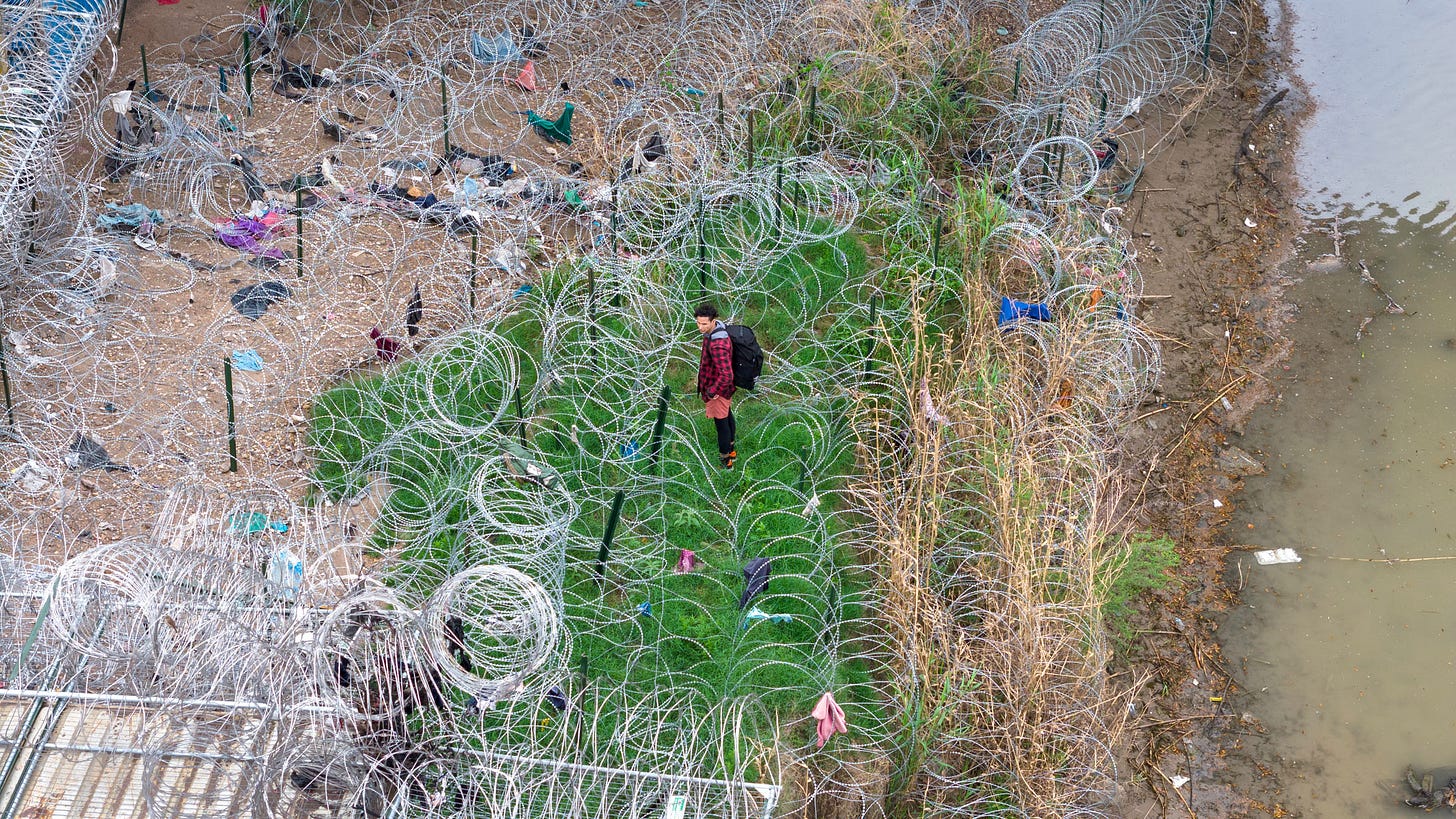
An immigrant faces coils of razor wire after crossing the Rio Grande from Mexico in Eagle Pass, Texas, on March 17. John Moore—Getty Images
John Moore’s image of a migrant ensnared in coils of razor wire starkly captures the complexity and chaos of the immigration issue. The controversial barrier, installed by the state of Texas in Eagle Pass and later challenged in the Supreme Court, is a potent metaphor for the obstruction of progress and defiance of logic.
Women’s Rights, Equality, and Reproductive Freedom (3 Photos)
- An activist cries during a debate on lifting Gambia’s 2015 ban on female genital mutilation at the National Assembly in Banjul on March 18. Though advanced initially, the bill was rejected in July. Carmen Yasmine Abd Ali
- Gil Howard, an 82-year-old retired professor turned driving instructor, helps Khalida Noori stay centered in a highway lane in Modesto, Calif., Feb. 21. Locals say he’s taught more Afghan women drivers there than exist in all of Afghanistan. Rachel Bujalski—The New York Times/Redux
I’m at a loss to understand how few images make up this category unless the relative lack of concern for women’s rights in 2024 is the big takeaway. While the Trump-Harris contest turned into a gender war battle and a record-breaking ten states had abortion-related initiatives on their ballots in November, you would never know it.

National Men’s March to Abolish Abortion and Rally for Personhood in Boston, Mass., on Nov. 16, 2024. Catholic radio host Jim Havens founded the march and previously came to Mass., where Gov. Maura Healey has said she would not enforce a national abortion ban. Sophie Park for the New York Times
I counted this image of a man at an anti-abortion march in the protest category. Still, I’m sharing it here because it highlights the lack of any other image in the 100 photos dealing with abortion or reproductive rights.
I would add that a quick tally shows that only about 25% of TIME’s list this year—a consistent finding across media lists year after year—features images taken by women photographers.
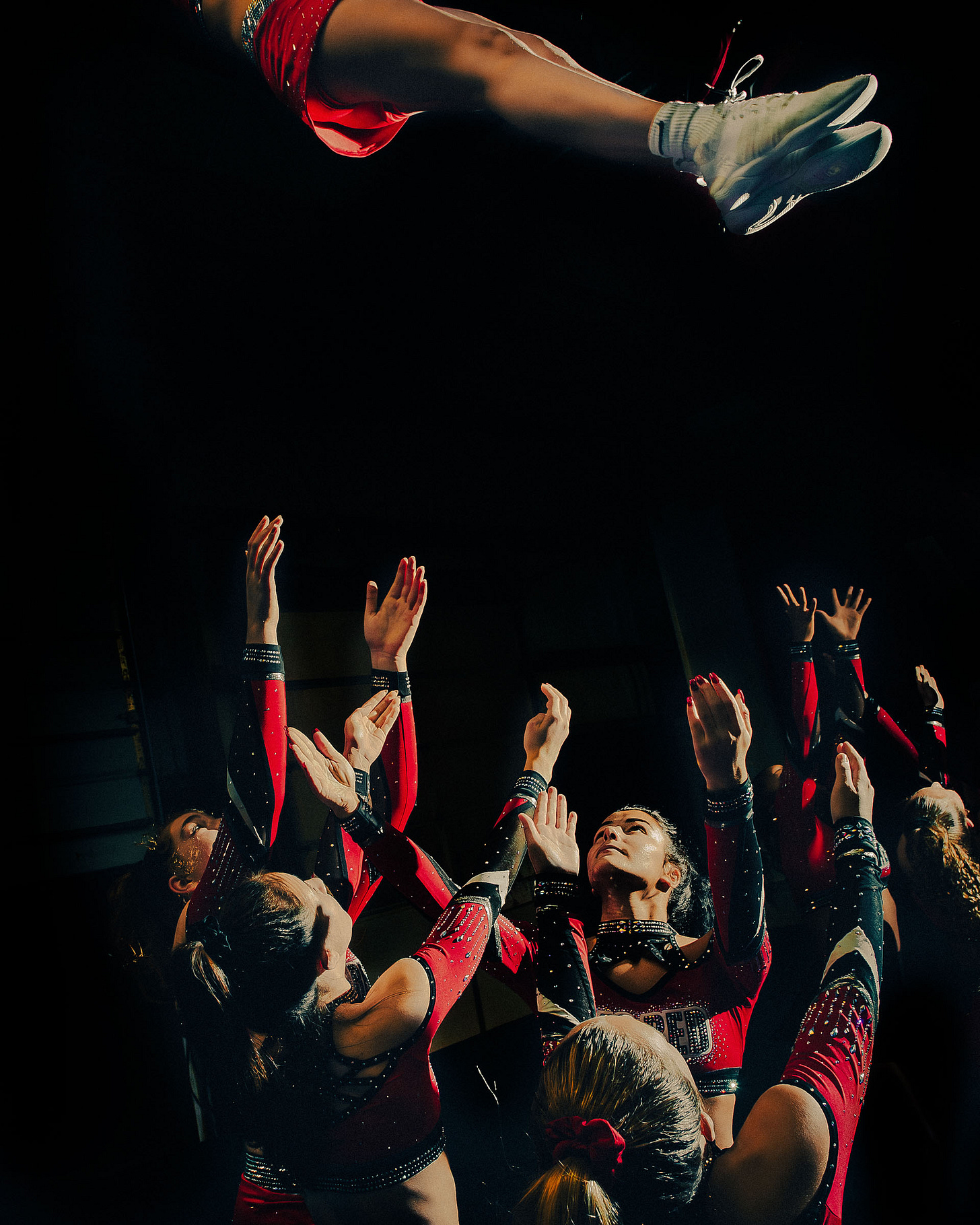
Cheerleaders practicing at Valley Elite All Stars on Oct. 3 in Allentown, PA. Dina Litovsky for The New York Times
What these selections are notable for is their documentary focus, offering a more profound treatment of women and culture. The third image, for example, is from an excellent set of photos by Dina Litovsky illustrating a NY Times Magazine exposé of the cheerleading organization Varsity Spirit, the exploitation leading to physical and financial harm to young women and their families across the country.
Social Violence and Domestic Terror (3 Photos)
- People flee after shots were fired near the Kansas City Chiefs’ Super Bowl LVIII victory parade in Kansas City, Missouri, on Feb. 14. Andrew Caballero-Reynolds—AFP/Getty Images
- Community members blow bubbles at a vigil in Southport, England, on Aug. 5 to mourn Bebe King, 6, Elsie Dot Stancombe, 7, and Alice Dasilva Aguiar, 9, who were killed in a knife attack during a Taylor Swift-themed dance class.Dan Kitwood—Getty Images
Of the three images referencing terror or acts of violence short of war, one addresses gun violence in America—a critical inclusion given the staggering toll it has taken in 2024. According to the Gun Violence Archive, there have been over 2,470 mass shootings this year, resulting in more than 115,000 deaths and 129,000 injuries, with firearms now the leading cause of death among children and teens in the U.S.
While the photo from Kansas City effectively conveys the fear and unpredictability of gun violence, it feels insufficient, given the magnitude of this crisis. Incidentally, the image of a vigil in England for the victim of a knife attack only makes the treatment of gun violence in America more cursory.
Poverty (2 Photos)
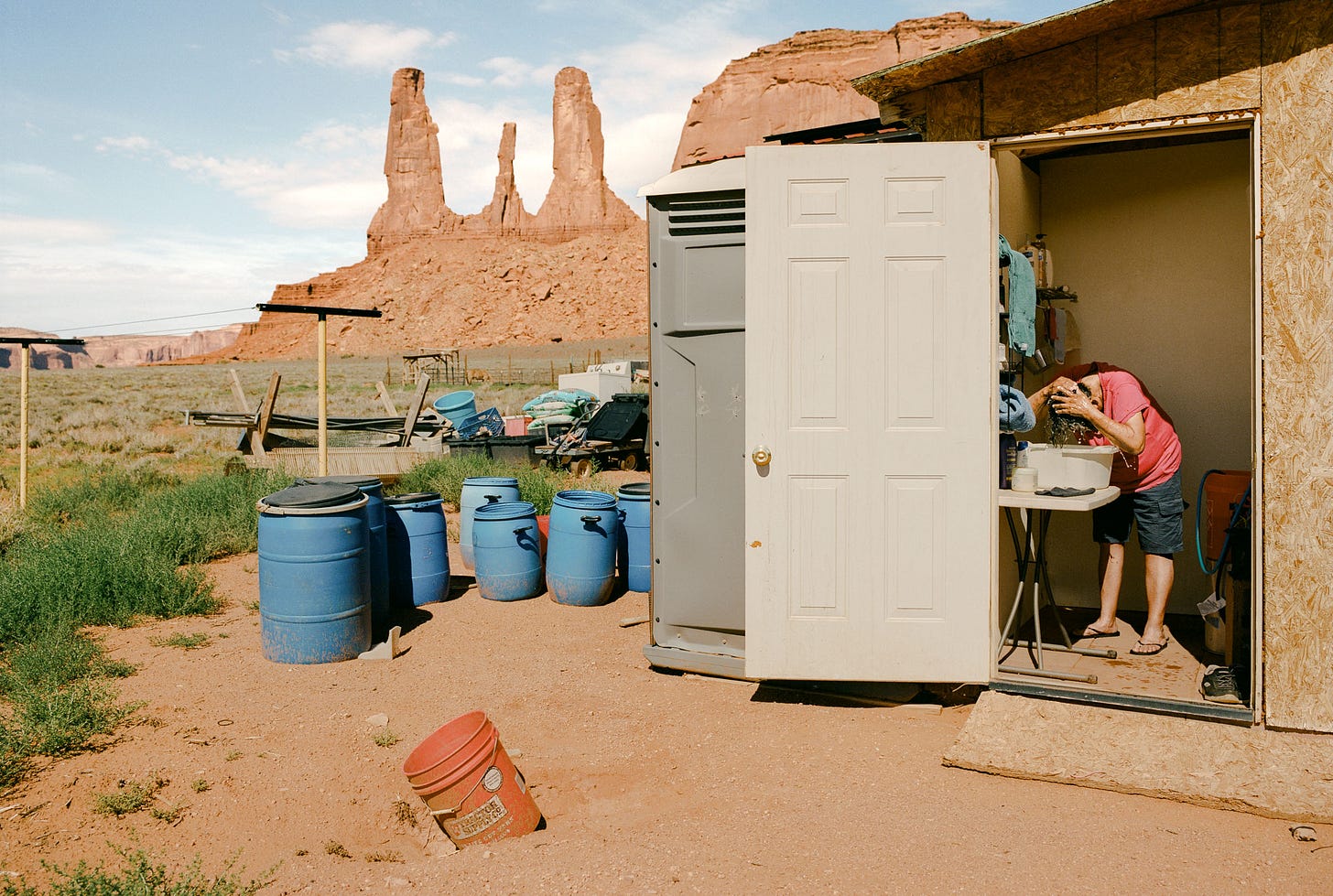
Linda Jackson washes her hair at her home in the Navajo Nation, on July 11. Elliot Ross for TIME
This category includes only two photos, the other from Fiji. Although an eloquent image and the rare scene of Native Americans, especially on their land, the lack of coverage says a lot about both the media and cultural status of the issue. That’s even more ironic after this year’s Supreme Court decision banning homeless people from sleeping outdoors and the financial profile of Donald Trump’s new administration, including at least eight confirmed billionaires with a combined net worth of over $344.4B.
A Last Word
Ultimately, TIME’s Top 100 Photos of 2024, like most of these yearly compendiums, provides a compelling yet incomplete visual chronicle of the year. Topics that were absent include physical and mental healthcare and substance abuse, the impact of tech on society, including social media and AI, labor movements and workers’ rights, environmental activism, oligarchy and plutocracy, and the growing scarcity of natural resources.
While the collection captures critical moments of conflict and challenge, the focus on visual drama and aesthetics, especially with the softer categories I skipped, risks diluting them into an exercise in infotainment. That’s not the worst thing if we are clear and specific about celebrating editorial photography. However, by leaning into its tradition of high-impact photojournalism, TIME’s list and others reinforce the role of photojournalism in raising consciousness and shaping public perception. That broader agenda raises questions about which stories are told from what angle and which remain unseen.
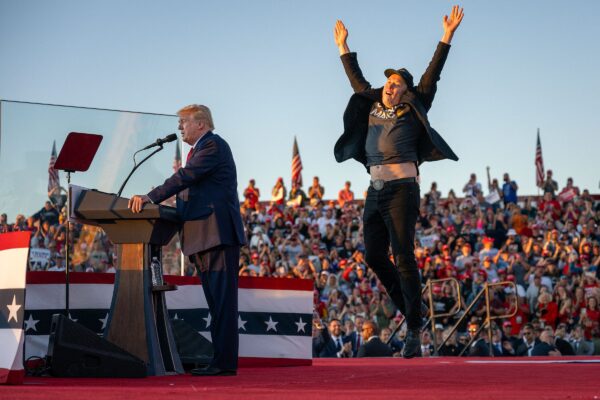

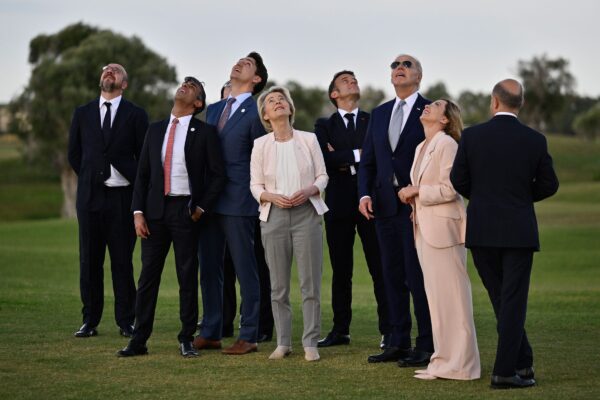




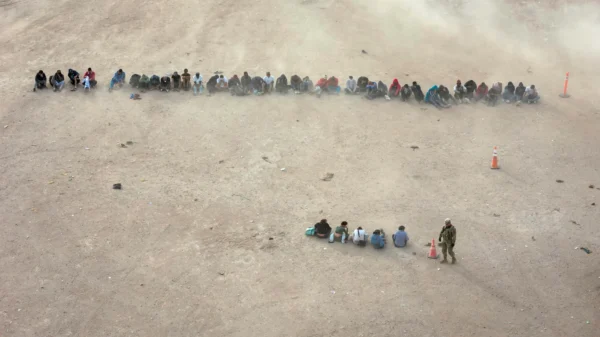
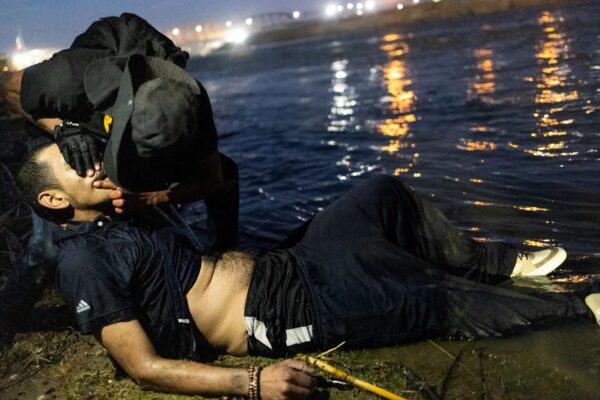

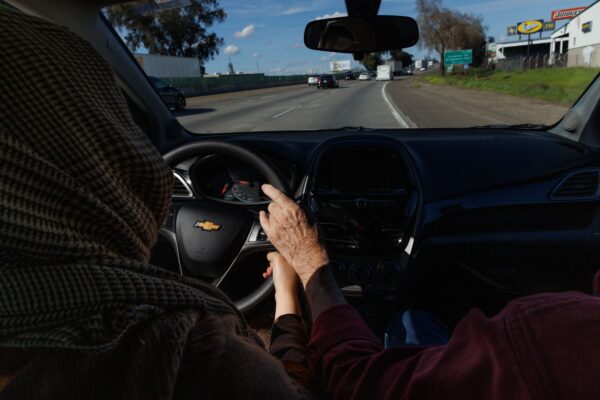

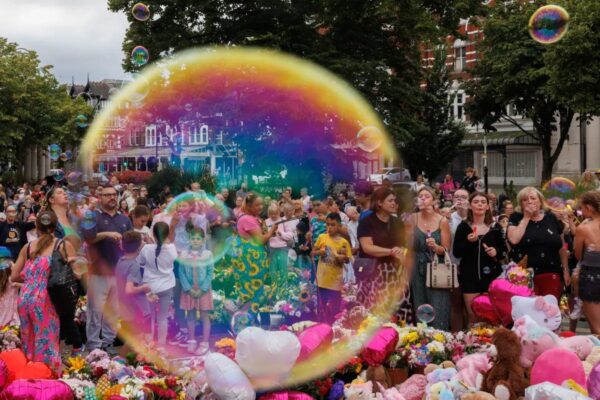
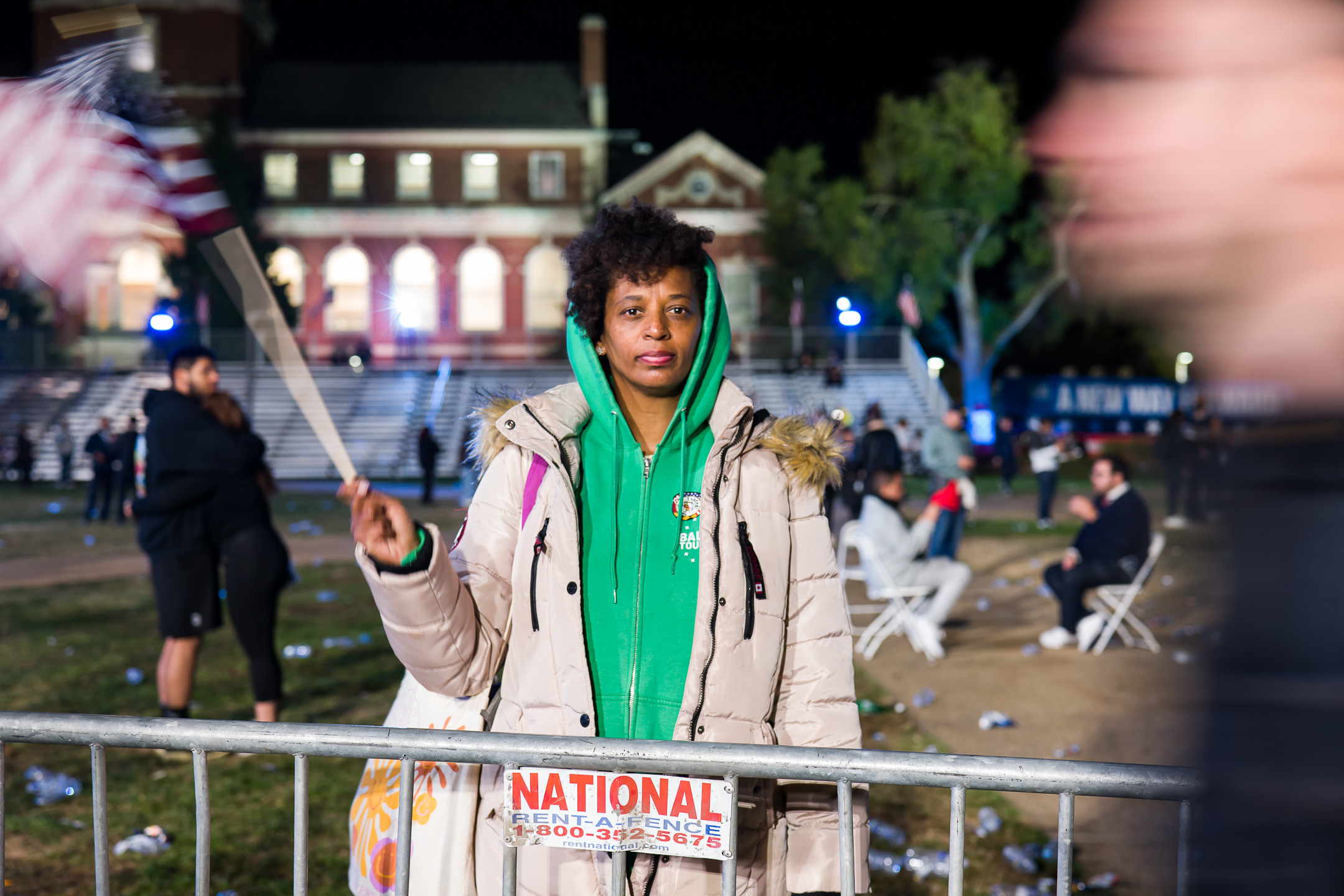
Reactions
Comments Powered by Disqus